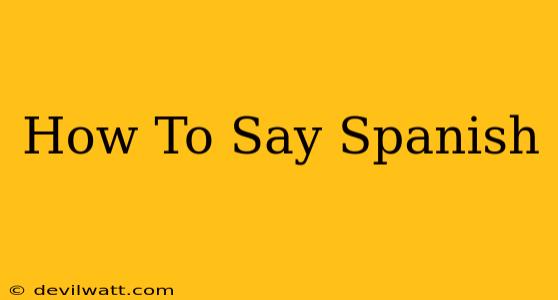Learning a new language can feel daunting, but Spanish, with its relatively straightforward grammar and widespread use, is an excellent choice for beginners. This guide provides a foundational understanding of how to say Spanish, covering pronunciation, basic phrases, and resources to help you on your journey.
Understanding Spanish Pronunciation
Mastering Spanish pronunciation is key to effective communication. While it might seem challenging at first, focusing on these elements will significantly improve your fluency:
Vowels:
Spanish vowels are pronounced consistently, unlike English. Each vowel has one distinct sound:
- A: as in "father"
- E: as in "bed"
- I: as in "machine"
- O: as in "go"
- U: as in "put"
Consonants:
Many Spanish consonants are similar to English, but some key differences exist:
- R: The "r" sound often has a rolled or trilled quality. Practice this sound until it feels natural.
- J & G (before I or E): These letters represent a "h" sound, similar to the ch in the Scottish word "loch."
- LL: This represents a "y" sound as in "yellow." (Note: the pronunciation varies regionally).
- Ñ: This represents a unique sound, a nasal "ny" as in "canyon."
Stress and Accent Marks:
Spanish words are stressed on specific syllables. Accent marks (´) indicate the stressed syllable. Learning the rules for stress placement will improve your pronunciation and comprehension.
Essential Spanish Phrases for Beginners
Starting with basic phrases is crucial for building confidence. Here are some essential greetings and common expressions:
- Hola: Hello
- Buenos días: Good morning
- Buenas tardes: Good afternoon/Good evening
- Buenas noches: Good night
- ¿Cómo está?: How are you? (formal)
- ¿Cómo estás?: How are you? (informal)
- Bien, gracias: Fine, thank you
- Por favor: Please
- Gracias: Thank you
- De nada: You're welcome
- Sí: Yes
- No: No
- Adiós: Goodbye
Resources for Learning How to Say Spanish
Numerous resources are available to help you on your Spanish-learning journey. Consider these options:
- Language Learning Apps: Duolingo, Babbel, and Memrise offer interactive lessons and gamified learning experiences.
- Online Courses: Coursera, edX, and other platforms provide structured courses taught by experienced instructors.
- Spanish Language Tutors: Private tutoring provides personalized instruction and feedback.
- Immersion: Immersing yourself in a Spanish-speaking environment, even if only through movies, music, or books, is invaluable.
Beyond Basic Phrases: Expanding Your Vocabulary
Once you've grasped the basics, expand your vocabulary by focusing on topics relevant to your interests. Learn words and phrases related to food, travel, work, or hobbies. Consistent practice is essential.
Practice Makes Perfect
Learning any language takes time and dedication. The more you practice speaking, listening, reading, and writing in Spanish, the faster you will improve. Don't be afraid to make mistakes – it's part of the learning process! Embrace the challenges and enjoy the rewarding journey of learning how to say Spanish.

